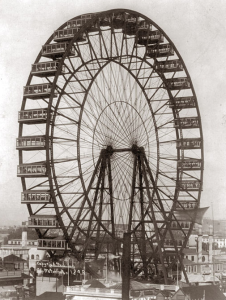A Snapshot from Chicago history
I happen to be working on two new projects, both of which are set in Chicago, so I’m up to my literary ears in research. In other words, I have Chicago on the brain.
The first time I traveled to Europe, nearly 30 years ago now . . . excuse me as I gasp over how old that makes me feel . . . when I told someone I was from Chicago they would mimic a machine gun and inform me I came from the city of gangsters like Capone and Bugs Moran.
Ah, but there is so much more! My research proves it.
Although my 1895 setting falls after the 1893 Columbian Exposition World’s Fair, my characters surely would have been aware of it and the city itself would reflect having hosted such an event. Some of the legacy we still see today—like Cracker Jacks, for example. And of course the famous Ferris wheel.
 The Ferris wheel is a story I almost wish I could include in my book. This original was far larger than any Ferris wheel we think of today. With 36 carriages each roughly the size of a train car, they were capable of holding 60 riders for a capacity of 2,160 people! It took 20 minutes per revolution, and cost 50 cents to ride two revolutions. Since most of the stories about the Columbian Exposition featured the giant wheel at least somewhere on its horizon, it obviously played an important part in the fair’s success.
The Ferris wheel is a story I almost wish I could include in my book. This original was far larger than any Ferris wheel we think of today. With 36 carriages each roughly the size of a train car, they were capable of holding 60 riders for a capacity of 2,160 people! It took 20 minutes per revolution, and cost 50 cents to ride two revolutions. Since most of the stories about the Columbian Exposition featured the giant wheel at least somewhere on its horizon, it obviously played an important part in the fair’s success.
But I said I almost wish I could include its story, and that’s because things didn’t end up so well for either the wheel itself or its inventor. After the fair closed in the fall of 1893, the Ferris wheel sat idle until the end of April, 1894. It was dismantled and taken to storage on flatbed train cars, but there were plans to use it again in Chicago’s Lincoln Park. Bonds were sold to improve the landscaping of the still largely undeveloped area, and there were plans to build a restaurant and band shell, a beer garden and vaudeville theater. But the community voted down the idea to sell alcohol, so the plans soured from there. To make matters worse, once the wheel opened again, patrons didn’t come to ride the engineering marvel. Evidently its novelty had worn off, or perhaps it needed the backdrop and excitement of a World’s Fair to make the event more memorable.
So the Ferris wheel was sold to a junk company. It did have a brief resurrection when it was moved to St. Louis for the 1904 World’s Fair, celebrating the Louisiana Purchase. Once again the wheel played an important part in a fair’s financial success, perhaps confirming my suspicion that the surroundings played an important role in attracting riders.
But the giant wheel set neglected again after that fair closed. In 1906 it was destroyed with 200 lbs of dynamite. Reports say it crumpled slowly and it took another 100 sticks to finish the job.
George Ferris himself died of typhoid fever at only 37 years old, before the wheel was used for the second time and after having fought Columbian Exposition organizers for his rightful share of revenue the wheel raised during the fair. More sad than that, Wikipedia says his ashes sat unclaimed for a year.
Research often tempts me to write more stories than I set out to do, and perhaps there is a story here . . . but I’ve pledged to write happy endings, so I guess I’ll leave this one to someone else!



